Out-of-Plane Behavior of Masonry Prisms Retrofitted with Shape Memory Alloy Stripes: Numerical and Parametric Analysis
Abstract
:1. Introduction
2. Description of the Finite Element Models
2.1. Boundary Conditions and Loading
2.2. Interactions and Constraint Conditions
2.3. Constitutive Models
2.3.1. Constitutive Model for Brick Units and Mortar Joints
2.3.2. Constitutive Model for SMA
2.4. Mesh Sensitivity Analysis
2.5. Finite Element Model Validation
3. Finite Element Analysis Results
4. Conclusions
- Because of the high stiffness of the SMA material, the SMA-reinforcing stripes reduced the maximum displacement in the masonry prisms from 15.06 mm to 0.17–0.33, depending on the SMA material and thickness.
- Thanks to the high stiffness and re-centering capabilities of SMA materials, the masonry prism’s residual displacement was reduced from 15.0 mm to 0.02 mm–0.06 mm, depending on the SMA material and thickness.
- Stripes formed from Ni-Ti SMA performed better than those made of Cu-Zn-Al in terms of improving masonry prism performance and lowering the damage incurred. Furthermore, increasing the thickness of the stripes was somewhat more efficient in Ni-Ti SMA stripes than in Cu-Zn-Al stripes.
- Although the SMA material used in the retrofitting strips greatly mitigated the damage to the masonry prism with good effect, recovery was not total. This issue could be related to strain interoperability and the large difference in stiffness between SMA and brittle materials such as brick and mortar. In order to appropriately address the issue, this might be a potential subject of future research.
Author Contributions
Funding
Institutional Review Board Statement
Informed Consent Statement
Data Availability Statement
Conflicts of Interest
References
- Abrams, D.; Angel, R.; Uzarski, J. Out-of-plane strength of unreinforced masonry infill panels. Earthq. Spectra 1996, 12, 825–844. [Google Scholar] [CrossRef]
- Shendkar, M.R.; Kontoni, D.P.N.; Işık, E.; Mandal, S.; Maiti, P.R.; Harirchian, E. Influence of Masonry Infill on Seismic Design Factors of Reinforced-Concrete Buildings. Shock Vib. 2022, 2022, 5521162. [Google Scholar] [CrossRef]
- Griffith, M.; Vaculik, J. Out-of-plane flexural strength of unreinforced clay brick masonry walls. TMS J. 2007, 25, 53–68. [Google Scholar]
- Javanmardi, A.; Ghaedi, K.; Huang, F.; Hanif, M.U.; Tabrizikahou, A. Application of Structural Control Systems for the Cables of Cable-Stayed Bridges: State-of-the-Art and State-of-the-Practice. Arch. Comput. Methods Eng. 2022, 29, 1611–1641. [Google Scholar] [CrossRef]
- Işık, E.; Harirchian, E.; Arkan, E.; Avcil, F.; Günay, M. Structural Analysis of Five Historical Minarets in Bitlis (Turkey). Buildings 2022, 12, 159. [Google Scholar] [CrossRef]
- Tabrizikahou, A.; Kuczma, M.; Nowotarski, P.; Kwiatek, M.; Javanmardi, A. Sustainability of Civil Structures through the Application of Smart Materials: A Review. Materials 2021, 14, 4824. [Google Scholar] [CrossRef] [PubMed]
- Javanmardi, A.; Ghaedi, K.; Ibrahim, Z.; Huang, F.; Kuczma, M.; Tabrizikahou, A.; Mohammad-Sedighi, H. Pounding mitigation of a short-span cable-stayed bridge using a new hybrid passive control system. Eng. Anal. Bound. Elem. 2022, 134, 625–636. [Google Scholar] [CrossRef]
- Ward, S. Retrofitting existing masonry buildings to resist explosions. J. Perform. Constr. Facil. 2004, 18, 95–99. [Google Scholar] [CrossRef]
- Mosallam, A.S. Out-of-plane flexural behavior of unreinforced red brick walls strengthened with FRP composites. Compos. Part Eng. 2007, 38, 559–574. [Google Scholar] [CrossRef]
- Karantoni, F.V.; Fardis, M.N. Effectiveness of Seismic Strengthening Techniques for Masonry Buildings. J. Struct. Eng. 1992, 118, 1884–1902. [Google Scholar] [CrossRef]
- Hutchison, D.; Yong, P.; McKenzie, G. Laboratory testing of a variety of strengthening solutions for brick masonry wall panels. In Proceedings of the 8th WCEE, San Francisco, CA, USA, 12–15 July 1984; pp. 575–582. [Google Scholar]
- Abrams, D.; Lynch, J. Flexural behavior of retrofitted masonry piers. In Proceedings of the KEERC-MAE Joint Seminar on Risk Mitigation for Regions of Moderate Seismicity, Champaign, IL, USA, 5–8 August 2001; pp. 234–243. [Google Scholar]
- ElGawady, M.; Lestuzzi, P.; Badoux, M. A review of conventional seismic retrofitting techniques for URM. In Proceedings of the 13th International Brick and Block Masonry Conference, Amsterdam, The Netherlands, 4–7 July 2004; pp. 1–10. [Google Scholar]
- Sheppard, P.; Tercelj, S. The effect of repair and strengthening methods for masonry walls. In Proceedings of the 7th World Conference on Earthquake Engineering, Istanbul, Turkey, 8–13 September 1980; Volume 6, pp. 255–262. [Google Scholar]
- Taghdi, M. Seismic Retrofit of Low-Rise Masonry and Concrete Walls by Steel Strips; University of Ottawa (Canada): Ottawa, ON, Canada, 1998. [Google Scholar]
- Carney, P.; Myers, J.J. Shear and Flexural Strengthening of Masonry Infill Walls with FRP for Extreme Out-of-Plane Loading. In Proceedings of the Architectural Engineering, Austin, TX, USA, 17–20 September 2003; pp. 1–5. [Google Scholar]
- Tabrizikahou, A.; Kuczma, M.; Łasecka-Plura, M.; Noroozinejad Farsangi, E.; Noori, M.; Gardoni, P.; Li, S. Application and modelling of Shape-Memory Alloys for structural vibration control: State-of-the-art review. Constr. Build. Mater. 2022, 342, 127975. [Google Scholar] [CrossRef]
- Kuczma, M.; Mielke, A. Influence of hardening and inhomogeneity on internal loops in pseudoelasticity. ZAMM 2000, 80, 291–306. [Google Scholar] [CrossRef]
- Otsuka, K.; Wayman, C.M. Shape Memory Materials; Cambridge University Press: Cambridge, UK, 1999. [Google Scholar]
- Casciati, S.; Hamdaoui, K. Experimental and numerical studies toward the implementation of shape memory alloy ties in masonry structures. Smart Struct. Syst. 2008, 4, 153–169. [Google Scholar] [CrossRef]
- Cardone, D.; Angiuli, R.; Gesualdi, G. Application of Shape Memory Alloys in Historical Constructions. Int. J. Archit. Herit. 2019, 13, 390–401. [Google Scholar] [CrossRef]
- Habieb, A.B.; Valente, M.; Milani, G. Hybrid seismic base isolation of a historical masonry church using unbonded fiber reinforced elastomeric isolators and shape memory alloy wires. Eng. Struct. 2019, 196, 109281. [Google Scholar] [CrossRef]
- Rezapour, M.; Ghassemieh, M.; Motavalli, M.; Shahverdi, M. Numerical Modeling of Unreinforced Masonry Walls Strengthened with Fe-Based Shape Memory Alloy Strips. Materials 2021, 14, 2961. [Google Scholar] [CrossRef]
- Tabrizikahou, A.; Kuczma, M.; Łasecka-Plura, M.; Noroozinejad Farsangi, E. Cyclic Behavior of Masonry Shear Walls Retrofitted with Engineered Cementitious Composite and Pseudoelastic Shape Memory Alloy. Sensors 2022, 22, 511. [Google Scholar] [CrossRef]
- Dauda, J.A.; Silva, L.C.; Lourenço, P.B.; Iuorio, O. Out-of-plane loaded masonry walls retrofitted with oriented strand boards: Numerical analysis and influencing parameters. Eng. Struct. 2021, 243, 112683. [Google Scholar] [CrossRef]
- Abaqus, G. Abaqus 6.11; Dassault Systemes Simulia Corporation: Providence, RI, USA, 2011. [Google Scholar]
- Addessi, D.; Marfia, S.; Sacco, E.; Toti, J. Modeling Approaches for Masonry Structures. Open Civ. Eng. J. 2014, 8, 288–300. [Google Scholar] [CrossRef] [Green Version]
- Lourenço, P.B.; Rots, J.G.; Blaauwendraad, J. Two approaches for the analysis of masonry structures: Micro and macro-modeling. Heron 1995, 40, 313–340. [Google Scholar]
- Iuorio, O.; Dauda, J.A.; Lourenço, P.B. Experimental evaluation of out-of-plane strength of masonry walls retrofitted with oriented strand board. Constr. Build. Mater. 2021, 269, 121358. [Google Scholar] [CrossRef]
- Willis, C.; Griffith, M.; Lawrence, S. Horizontal Bending of Unreinforced Clay Brick Masonry; British Masonry Society: Edinburgh, UK, 2004. [Google Scholar]
- Abrams, D.P.; AlShawa, O.; Lourenço, P.B.; Sorrentino, L. Out-of-Plane Seismic Response of Unreinforced Masonry Walls: Conceptual Discussion, Research Needs, and Modeling Issues. Int. J. Archit. Herit. 2017, 11, 22–30. [Google Scholar] [CrossRef]
- Lubliner, J.; Oliver, J.; Oller, S.; Oñate, E. A plastic-damage model for concrete. Int. J. Solids Struct. 1989, 25, 299–326. [Google Scholar] [CrossRef]
- Lee, J.; Fenves, G.L. Plastic-Damage Model for Cyclic Loading of Concrete Structures. J. Eng. Mech. 1998, 124, 892–900. [Google Scholar] [CrossRef]
- Dauda, J.A.; Iuorio, O.; Lourenço, P.B. Numerical analysis and experimental characterisation of brick masonry. Int. J. Mason. Res. Innov. 2020, 5, 321–347. [Google Scholar] [CrossRef]
- Dauda, J.; Iuorio, O.; Paulo, L. Characterization of brick masonry: Study towards retrofitting URM walls with timber-panels. In Proceedings of the 10th International Masonry Conference (10thIMC), IMC, Milan, Italy, 9–11 July 2018. [Google Scholar]
- Auricchio, F.; Taylor, R.L. Shape-memory alloys: Modelling and numerical simulations of the finite-strain superelastic behavior. Comput. Methods Appl. Mech. Eng. 1997, 143, 175–194. [Google Scholar] [CrossRef]
- Auricchio, F.; Taylor, R.L.; Lubliner, J. Shape-memory alloys: Macromodelling and numerical simulations of the superelastic behavior. Comput. Methods Appl. Mech. Eng. 1997, 146, 281–312. [Google Scholar] [CrossRef]
- Tabrizikahou, A.; Hadzima-Nyarko, M.; Kuczma, M.; Lozančić, S. Application of Shape Memory Alloys in Retrofitting of Masonry and Heritage Structures Based on Their Vulnerability Revealed in the Bam 2003 Earthquake. Materials 2021, 14, 4480. [Google Scholar] [CrossRef]
- Pereiro-Barceló, J.; Bonet, J.L. Ni-Ti SMA bars behaviour under compression. Constr. Build. Mater. 2017, 155, 348–362. [Google Scholar] [CrossRef] [Green Version]
- Fu, S.; Huo, Y.; Müller, I. Thermodynamics of pseudoelasticity ?an analytical approach. Acta Mech. 1993, 99, 1–19. [Google Scholar] [CrossRef]
- Huo, Y.; Müller, I. Nonequilibrium thermodynamics of pseudoelasticity. Contin. Mech. Thermodyn. 1993, 5, 163–204. [Google Scholar] [CrossRef]
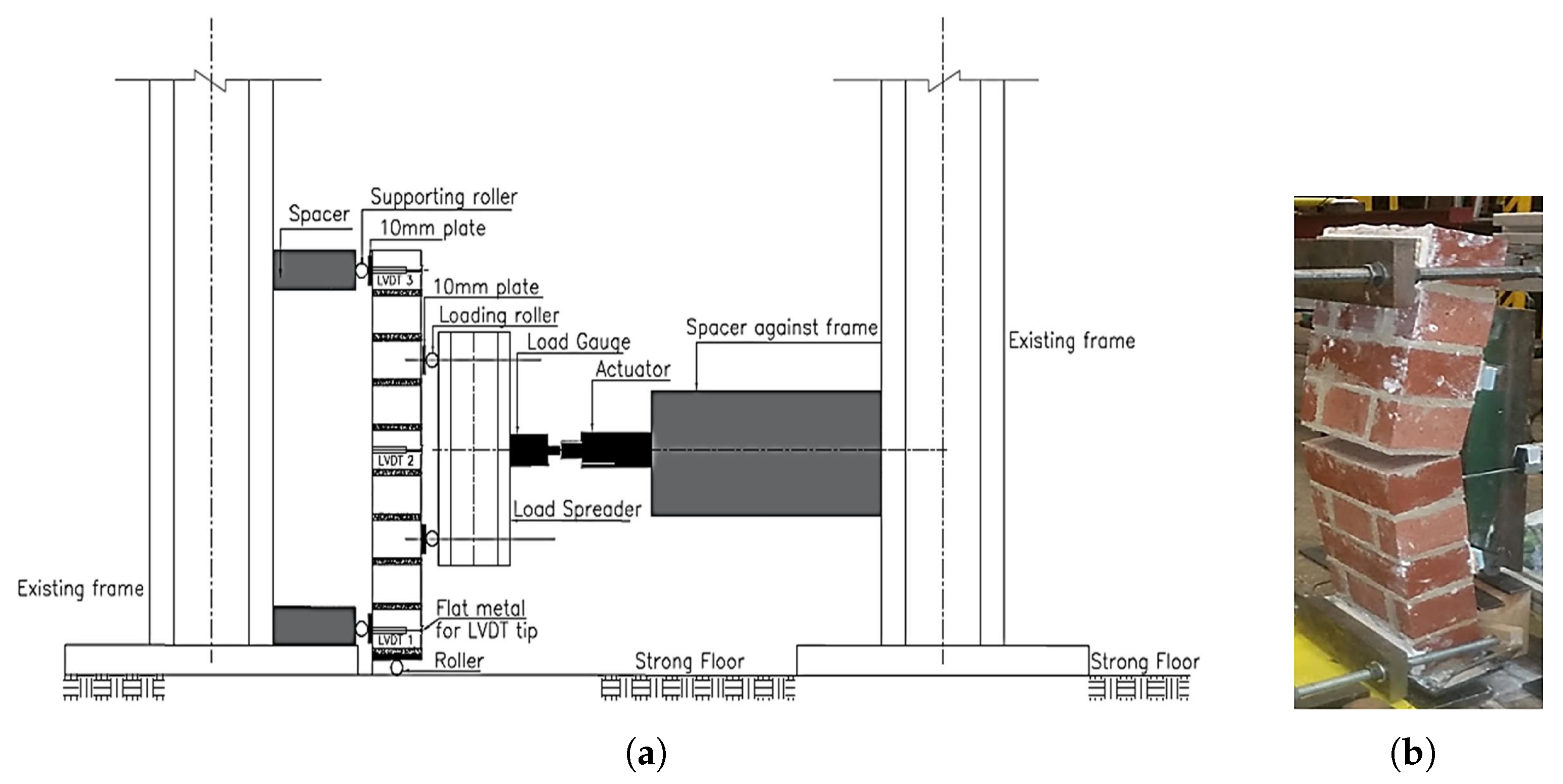



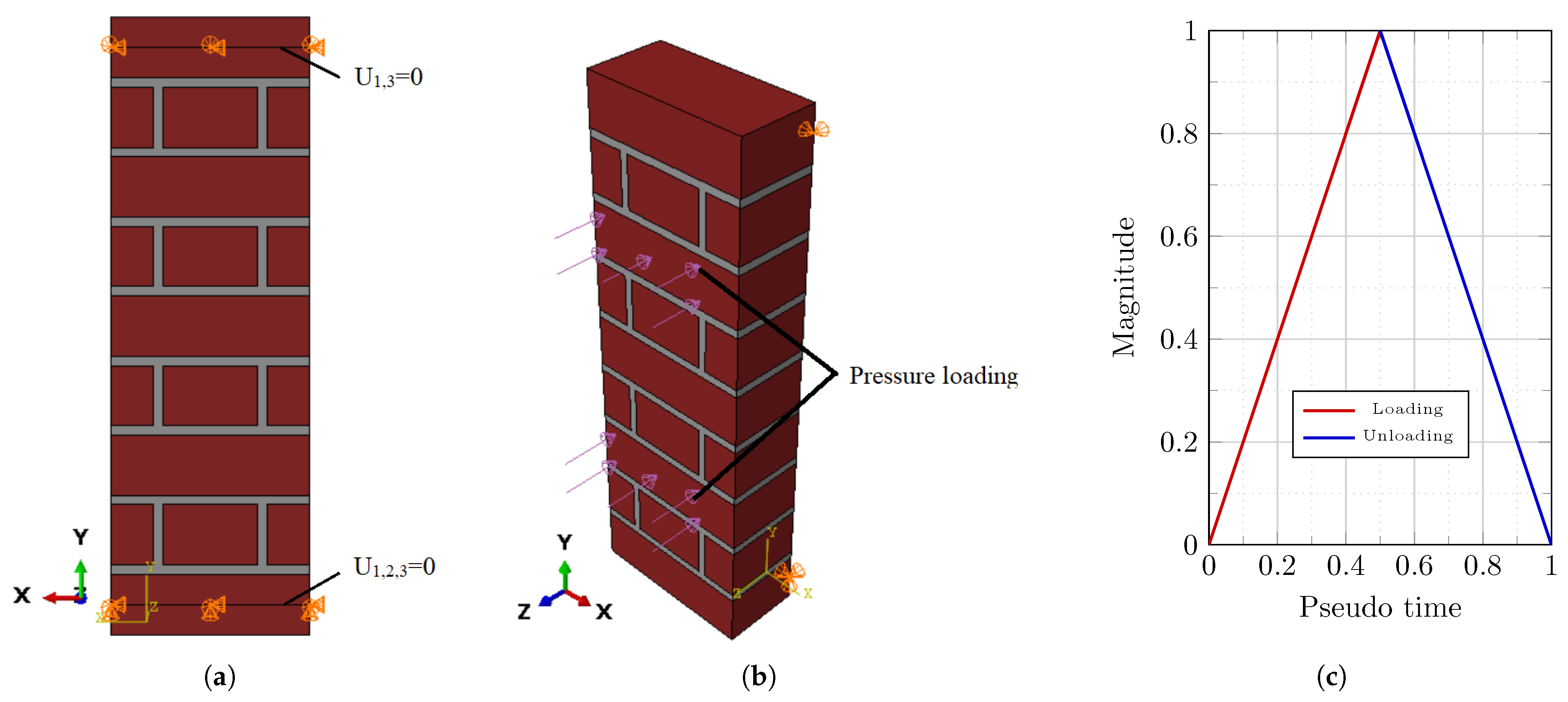
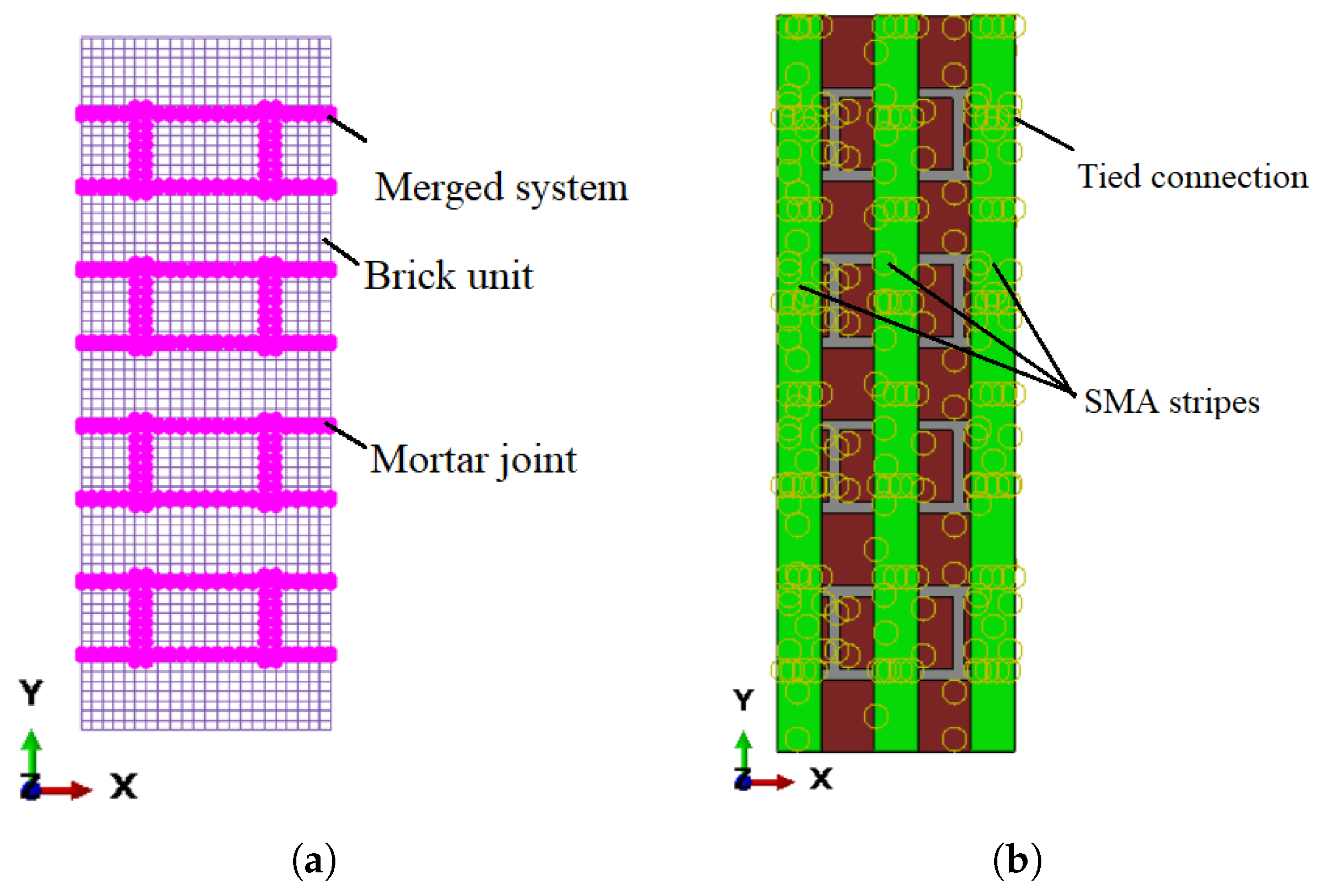

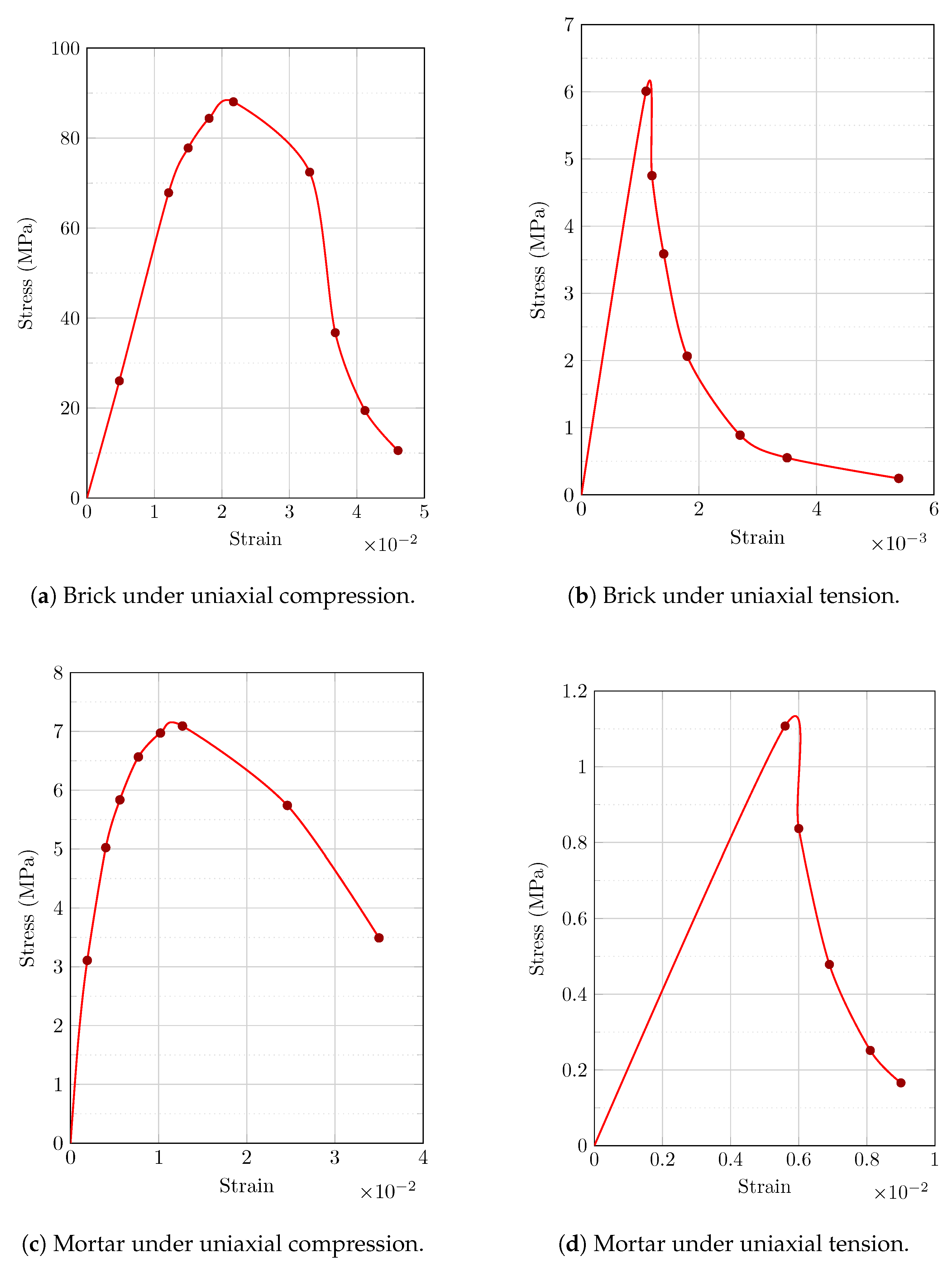
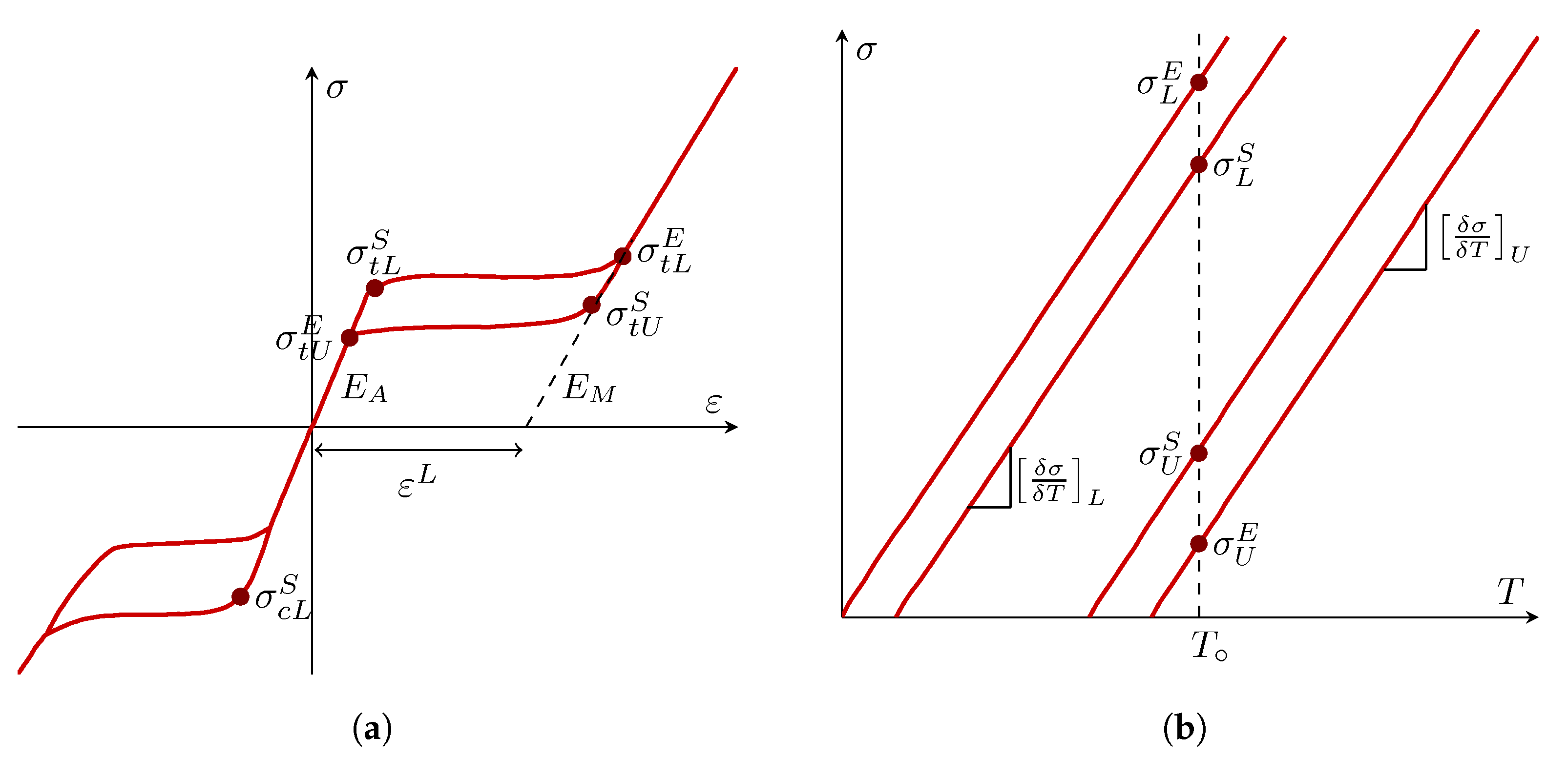


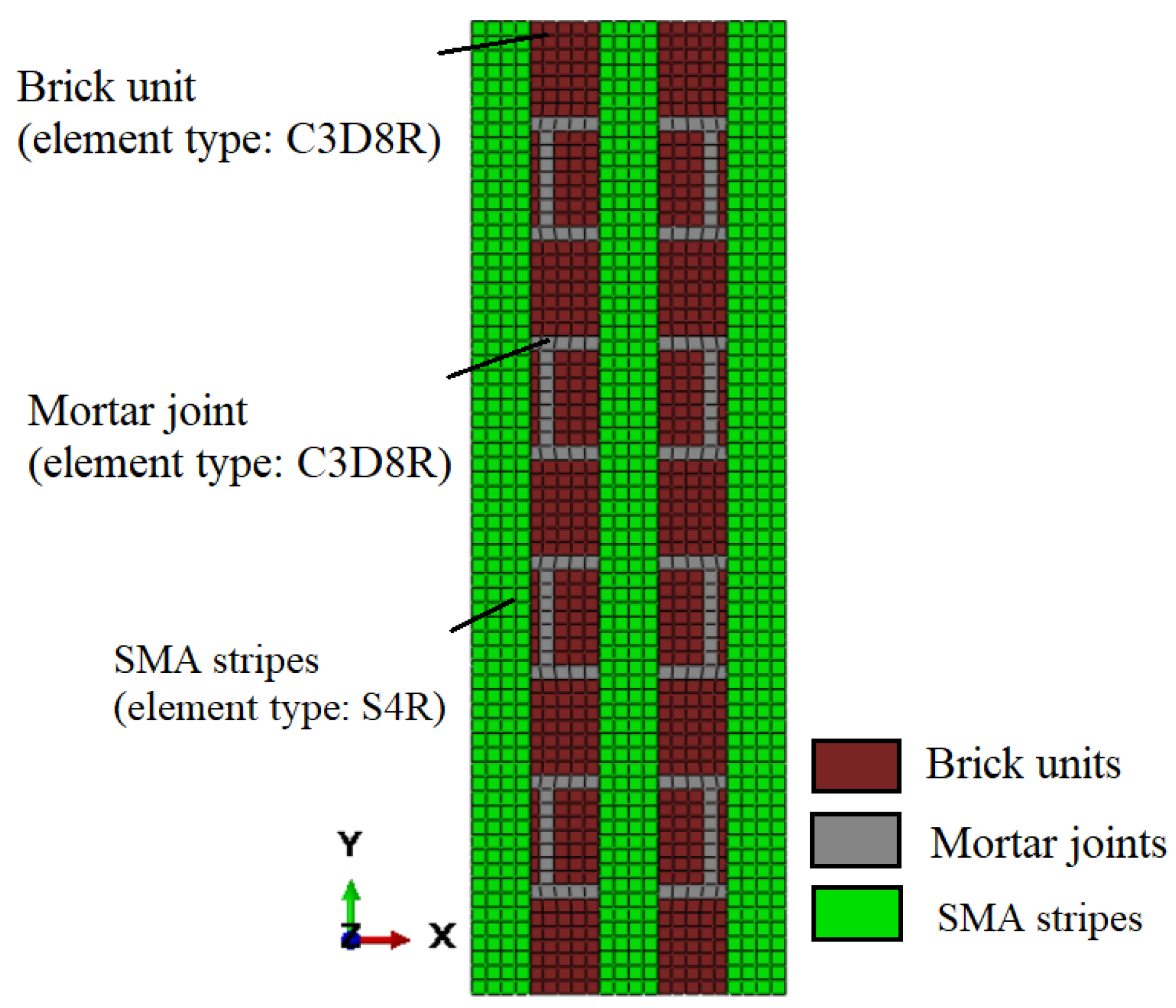

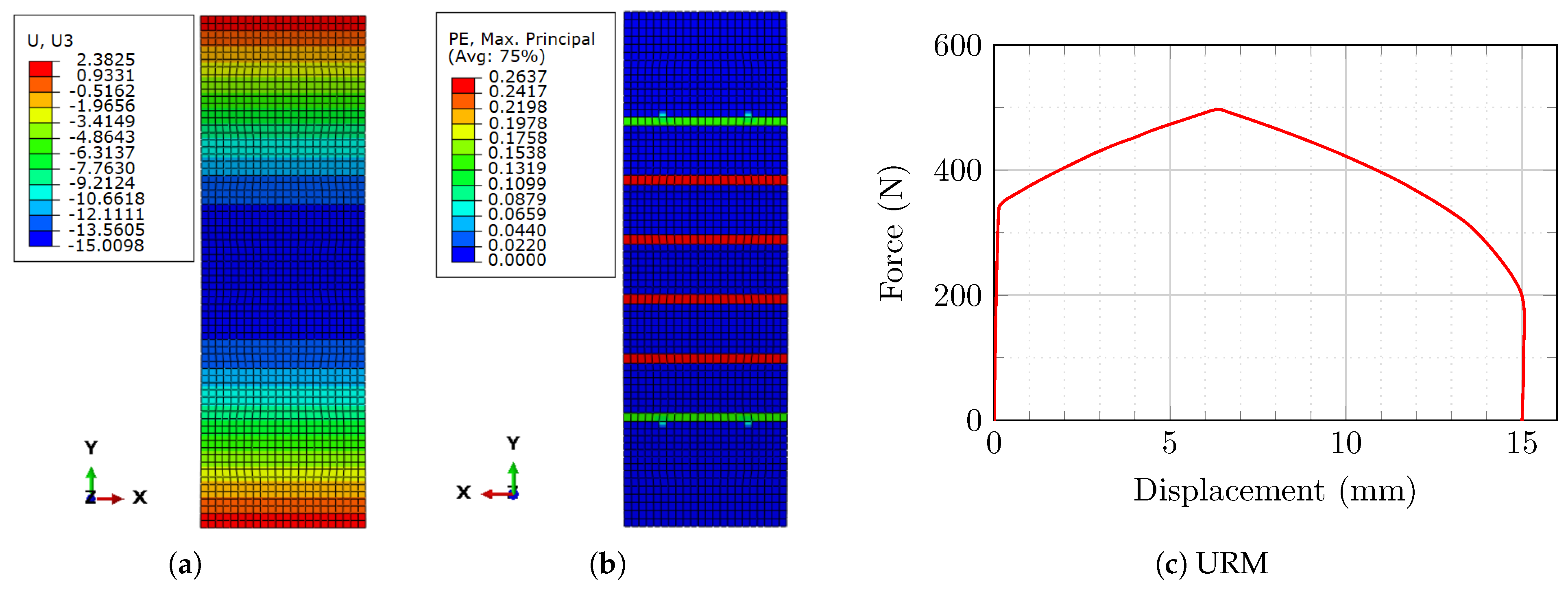
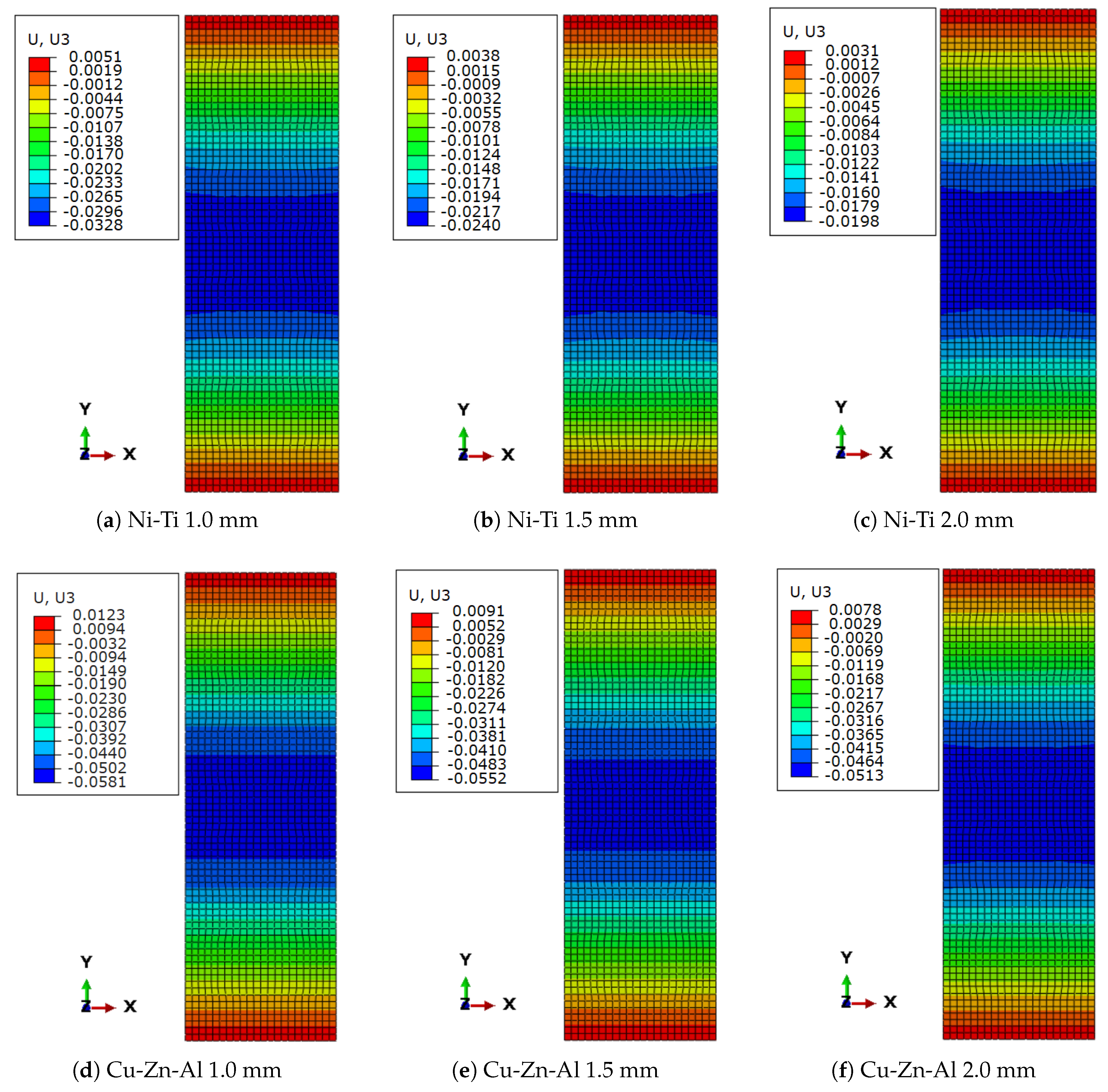


| Brick units | |||
|---|---|---|---|
| Compression stiffening properties | Tension stiffening properties | ||
| Yield stress (MPa) | Inelastic strain | Yield stress (MPa) | Cracking strain |
| 26.12 | 0 | 5.93 | 0 |
| 68.16 | 0.0081 | 4.74 | 0.0002 |
| 77.89 | 0.0114 | 3.52 | 0.0005 |
| 84.54 | 0.0144 | 2.04 | 0.0009 |
| 87.78 | 0.0187 | 0.90 | 0.0020 |
| 72.33 | 0.0313 | 0.52 | 0.0030 |
| 36.78 | 0.0352 | 0.23 | 0.0053 |
| 18.85 | 0.0403 | - | - |
| 10.66 | 0.0460 | - | - |
| Mortar joints | |||
| Compression stiffening properties | Tension stiffening properties | ||
| Yield stress (MPa) | Inelastic strain | Yield stress (MPa) | Cracking strain |
| 1.74 | 0 | 1.11 | 0 |
| 3.10 | 0.0008 | 0.83 | 0.0009 |
| 4.99 | 0.0032 | 0.48 | 0.0030 |
| 5.84 | 0.0048 | 0.25 | 0.0058 |
| 6.51 | 0.0069 | 0.16 | 0.0079 |
| 6.98 | 0.0095 | - | - |
| 7.07 | 0.0120 | - | - |
| 5.72 | 0.0242 | - | - |
| 3.48 | 0.0348 | - | - |
| Property | Unit | Ni-Ti [39] | Cu-Zn-Al [40,41] |
|---|---|---|---|
| Mpa | 64,647 | 21,000 | |
| Mpa | 28,125 | 16,000 | |
| - | 0.33 | 0.33 | |
| - | 0.33 | 0.33 | |
| % | 9.0 | 7.5 | |
| Mpa | 450 | 55 | |
| Mpa | 700 | 60 | |
| Mpa | 200 | 45 | |
| Mpa | 30 | 40 | |
| Mpa | 450 | 55 |
| Experimental [25] | Numerical | Difference (%) | |
|---|---|---|---|
| Peak load (N) | 2860 | 2795 | 2.27 |
| Displacement at peak load (mm) | 0.058 | 0.055 | 5.00 |
| Max. Plastic Strain | Max. Displacement (mm) | Residual Displacement (mm) | Recovery (%) | |
|---|---|---|---|---|
| URM | 0.2637 | 15.06 | 15.000 | 0.40 |
| URM with Ni-Ti 1.0 mm | 0.0007 | 0.29 | 0.033 | 88.62 |
| URM with Ni-Ti 1.5 mm | 0.0005 | 0.20 | 0.024 | 88.00 |
| URM with Ni-Ti 2.0 mm | 0.0004 | 0.17 | 0.020 | 88.23 |
| URM with Cu-Zn-Al 1.0 mm | 0.0017 | 0.33 | 0.064 | 80.06 |
| URM with Cu-Zn-Al 1.5 mm | 0.0014 | 0.30 | 0.055 | 81.60 |
| URM with Cu-Zn-Al 2.0 mm | 0.0011 | 0.29 | 0.051 | 82.40 |
Publisher’s Note: MDPI stays neutral with regard to jurisdictional claims in published maps and institutional affiliations. |
© 2022 by the authors. Licensee MDPI, Basel, Switzerland. This article is an open access article distributed under the terms and conditions of the Creative Commons Attribution (CC BY) license (https://creativecommons.org/licenses/by/4.0/).
Share and Cite
Tabrizikahou, A.; Kuczma, M.; Łasecka-Plura, M. Out-of-Plane Behavior of Masonry Prisms Retrofitted with Shape Memory Alloy Stripes: Numerical and Parametric Analysis. Sensors 2022, 22, 8004. https://doi.org/10.3390/s22208004
Tabrizikahou A, Kuczma M, Łasecka-Plura M. Out-of-Plane Behavior of Masonry Prisms Retrofitted with Shape Memory Alloy Stripes: Numerical and Parametric Analysis. Sensors. 2022; 22(20):8004. https://doi.org/10.3390/s22208004
Chicago/Turabian StyleTabrizikahou, Alireza, Mieczysław Kuczma, and Magdalena Łasecka-Plura. 2022. "Out-of-Plane Behavior of Masonry Prisms Retrofitted with Shape Memory Alloy Stripes: Numerical and Parametric Analysis" Sensors 22, no. 20: 8004. https://doi.org/10.3390/s22208004







